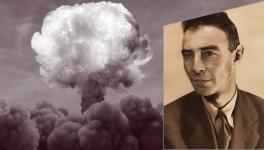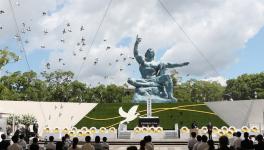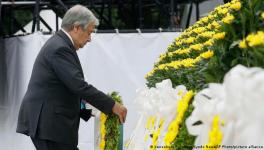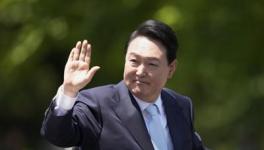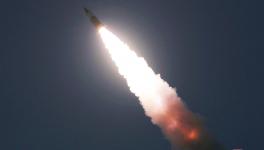Remembering Hiroshima with Our Doomsday Clock at Two Minutes to Midnight-Replug
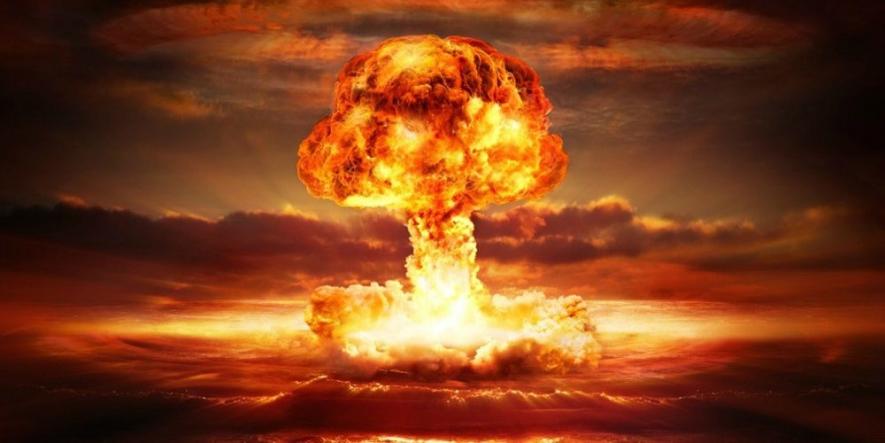
Today is the 74th anniversary of the dropping of the nuclear bomb on Hiroshima by the United States. The past couple of years have seen a drastic reversal of the disarmament process. The Donald Trump administration has been in the forefront of this process, its formal withdrawal from the Intermediate Range Nuclear Forces Treaty being only the latest example. At a time when talk of a new generation of deadly weapons has become passe, we republish this article from last year which examines the apocalyptic logic that has brought us to where we are today.
We need to remember Hiroshima and the horrific picture of its dead and the dying. “It was a procession of ghosts, in an instant all clothing burned off, hands, faces and breasts swelled. The purple blisters on their skin were soon burst and peeled off hanging down like pieces of rags. With hands lifted half up, they were ghosts in procession. Dragging their ragged skin behind them exhausted, they fell down moaning in heaps and died one after another.” (Maruki Gallery, Hiroshima Panels).
We need to remember Hiroshima, as the Doomsday Clock, created by the Bulletin of the Atomic Scientists in 1949, stands today at 2 minutes to midnight; or 2 minutes to nuclear Armageddon. This is the closest it has ever been, apart from the Cuban Missile Crisis of 1962. As a 15-year-old, I still remember the Cuban Missile Crisis, and how close we were to a nuclear exchange. The difference between the Cuban Missile Crisis and now, is that the two protagonists, the US and Soviet Union, and the rest of the world, were fully aware then of how close we were to extinction as a species. What is frightening about the current nuclear scenario, is that the world seems to be sleepwalking to a nuclear war and a nuclear Armageddon. The Doomsday Clock, ticking its way to midnight, is now only a small disturbance in our lives.
How did we reach this pass? After 1990, the US believed that it had won the Cold War, and Russia needed to be treated as a subjugated nation. The Russian leaders, Gorbachov, Yeltsin and Putin, believed that Russia’s future lies with Europe, and they should be treated as partners. They also thought that assurances that the US and its NATO allies, that NATO would not extend eastwards even by an inch, would be honoured. Instead, the US and NATO decided that Russia was, at best, a second rate regional power, which could be threatened and beaten into submission. As Obama stated, a second rate power, with at best regional influence.
It is with this understanding, the US decided not only to expand NATO eastwards, but also pulled out of the Anti-Ballistic Missile (ABM) Treaty in 2002. The ABM Treaty was a recognition that nuclear war was not winnable. If a country struck first and took out the bulk of its opponents’ weapons, could it then survive a retaliatory strike, particularly, if it had ABM shields? One way to counter such shields and ride out a first strike would be to increase the number of weapons. This was why, at the height of the Cold War, the US and Soviet Union had stockpiled 60,000 nuclear warheads.
The ABM treaty put at rest – at least for a time, the belief that the nuclear wars were like any other wars, and winnable. It was the recognition that such a course was no longer tenable. Both sides decided not to deploy shields that would only tempt the other side to increase the number of warheads. It was also the beginning of the Strategic Arms Limitation Treaties, and later the Strategic Arms Reduction Treaties (START). That is why the nuclear stockpile has come down from 60,000 then to about 14,500. Of course, this still can destroy all life on earth 40 times over, but nevertheless a step forward compared to the past.
Today, not only has the US pulled out of the ABM Treaty, START II expires in 2021, and Intermediate-Range Nuclear Forces Treaty (INF) in 2019. No new talks towards nuclear disarmament, a commitment made by the nuclear weapons states during the 1967 Nuclear Non Proliferation Treaty, are being held. Obama initiated a trillion dollar plan for the modernisation of US nuclear weapons. Going further, the US, in its 2018 Nuclear Posture Review under Trump, has talked about non-strategic nuclear weapons, and the use of nuclear weapons against non-nuclear attacks. Both represent a dangerous escalation in the risk of use of nuclear weapon.
With the US setting up nuclear shields on Russian borders, as well as missile bases in Romania and Poland, Russian response has been to announce a new generation of nuclear weapons in various stages of development. All of which are geared to overwhelming the missile shields. From dismantling of nuclear weapons, we are back again to a nuclear race; or a race towards total annihilation.
Though the Russian response of creating new weapons to defeat the ABM shield was predictable, it does not make it any less dangerous. These weapons are: long range cruise missiles that fly underneath the radar of ABM shields, missiles with extremely long range; underwater drones; hypersonic missiles; SARMAT, a 200-ton long range intercontinental missile that can hit the US from any direction, and therefore make obsolete the US missile shield in Alaska. Significantly, Putin ended his two-hour speech to the Federal Assembly of the Russian Federation while announcing the new weapons that now the US should recognise that Russia is not weak and “You will talk”.
As yet, there is no recognition, either in the US or in other capitals that we have entered a new arms race, with unpredictable consequences. And that we need to talk.
The US media houses, which today control global media, have spun a story of an aggressive Russia, and a dangerous Putin. What is not mentioned in this narrative, is the eastward expansion of NATO, and the comparative defence expenditures of NATO countries and Russia.
Since the NATO budget has come into focus with Trump demanding NATO allies spend more, let us look at the respective budgets of NATO counties, Russia, China and a few others. According to SIPRI, NATO, spent nearly 1 trillion dollars – $957 billion to be exact – against $66.3 billion by Russia. NATO’s defence budget is nearly 15 timesthat of Russia. The US alone spent $686 billion, or more than 10timesRussia’s defence expenditure. While Trump may be trumpeting that his other allies must spend more, the rest of the NATO allies already spend four and half timesmore than Russia on defence. And NATO’s eastward march clearly shows who is NATO’s enemy.
Just to put this in perspective, NATO spent 55 per cent of the total global defence expenditure of $1.74 trillion in 2017. Saudi Arabia, a NATO ally in West Asia spends an astonishing $69.3 billion and more than Russia’s defence spending. Compared to the Saudis, Iran spends a measly $14 billion – or one-fifth of Saudi Arabia’s defence budget.
The Nobel Peace Prize in 2017 was awarded to the International Campaign to Abolish Nuclear Weapons. Its advocacy led to 122 of the UN member states adopting the Treaty on the Prohibition of Nuclear Weapons in July 2017. The problem is that it does not include any of the nine nuclear states. Without this, it becomes equivalent to NPT, where the nuclear states continue their monopoly, while preaching the virtue of non-proliferation to the others.
Today, the US Nuclear Posture Review 2018 argues for increasingthe role of nuclear weapons. It states that nuclear weapons can be used against what it terms as “significant non-nuclear strategic attacks” against its allies and forces. George Perkovich, a well-known author and commentator on nuclear issues, summed up it quite accurately. He asked, “Really? We’re Gonna Nuke Russia for a Cyber attack?” (Politico, January 18, 2018).
The world stands at crossroads. As much as it did in 1967, when majority of countries signed the NPT in the belief that it would be followed by nuclear disarmament talks between the nuclear powers. Instead, the nuclear weapon states, particularly the US, have argued for their continued “need” of nuclear weapons. The US has never agreed to commit to a no-first use pledge; or not attacking countries without a UN mandate. Unless the people, including the people of the nuclear weapon states, build a broad movement for peace and nuclear disarmament, humanity has a bleak future.
Initially Published on August 16, 2018
Get the latest reports & analysis with people's perspective on Protests, movements & deep analytical videos, discussions of the current affairs in your Telegram app. Subscribe to NewsClick's Telegram channel & get Real-Time updates on stories, as they get published on our website.










